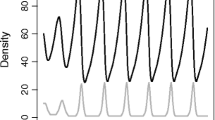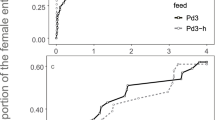Summary
Hassell andVarley described a negative relationship between the Nicholsonianarea of discovery and parasitoid density that permits coexistence of two or more parasitoid species and yields stability. They ascribed the relationship to “mutual interference” among searching parasitoid adults, leading to a “decreased efficiency”. This matter has recently been studied in more detail byHassell and coworkers. Negative relationships can occur for several reasons. In the present paper it is shown that the negative relation occurs under certain assumptions about the way parasitoid eggs are distributed among hosts. Several “contagious” (or “clustered”) distributions were studied. Those assuming variation in host susceptibility or accessibility (negative binomial and added zeros distributions) yielded negative relations. Those assuming variation in parasitoid aggressiveness and fecundity (Neyman Type A distributions) yielded variable results depending on how the distributions of parasitoids per host and of eggs per parasitoid were combined. It was found that, when analyzing actual data, sampling fluctuations can introduce strong negative relations either with or without “contagion”. In all instances, the relation betweenarea of discovery and parasitoid density is affected by host density and is, in general, not linear. The foregoing findings raise serious questions about thearea of discovery concept. An alternative approach is suggested.
Similar content being viewed by others
References
Griffiths, K. J. (1969) The importance of coincidence in the functional and numerical responses of two parasites of the European pine sawfly,Neodiprion sertifer.Can. Ent.101: 673–713.
Griffiths, K. J., andC. S. Holling (1969) A competition submodel for parasites and predators.Can. Ent.101: 785–818.
Hassell, M. P. (1971) Mutual interference between searching insect parasites.J. Anim. Ecol.40: 473–486.
Hassell, M. P., andR. M. May (1973) Stability in insect host-parasite models.J. Anim. Ecol.42: 693–726.
Hassell, M. P., andR. M. May (1974) Aggregation of predators and insect parasites and its effect on stability.J. Anim. Ecol.43: 567–594.
Hassell, M. P., andD. J. Rogers (1972) Insect parasite responses in the development of population models.J. Anim. Ecol.41: 661–676.
Hassell, M. P., andG. C. Varley (1969) New inductive population model for insect parasities and its bearing on biological control.Nature223 (5211): 1133–1137.
Huffaker, C. B., andP. S. Messenger (1964) The concept and significance of natural control. pp. 74–117. InBiological Control of Insect Pests and Weeds (P. DeBach, ed.). Reinbold Pub., New York.
Huffaker, C. B., andR. E. Stinner (1972) The role of natural enemies in pest control programs. InEntomological Essays to Commemorate the Retirement of ProfessorK. Yasumatsu. (Z. Hidakaet al., ed.), Hokuryukan Publ. Co., Tokyo.
Nicholson, A. J. (1933) The balance of animal populations.J. Anim. Ecol. Suppl.2 (1): 132–178.
Nicholson, A. J., andV. A. Bailey (1935) The balance of animal populations Part 1.Proc. Zool. Soc. London, Part 3: 551–598.
Rogers, D. J., andM. P. Hassell (1974) General models for insect parasite and predator searching behaviour: interference.J. Anim. Ecol.43: 239–253.
Royama, T. (1971) A comparative study of models for predation and parasitism.Res. Popul. Ecol. Suppl.1: 1–91.
Stinner, R. E. (1976) Ovipositional response ofVenturia canescens (Grav.) (Hymenoptera: Ichneumonidae) to various host and parasite densities.Res. Popul. Ecol.18: 57–73.
Author information
Authors and Affiliations
Additional information
The initial phase of this study was supported by National Institute of Health Grant S-Rol-AI0611, under Prof.C. B. Huffaker, Division of Biological Control, Department of Entomology, University of California, Berkeley. The study was completed under National Science Foundation Grant GB38271X.
Paper no. 4705 of the Journal Series of the North Carolina Agricultural Experiment Station Raleigh.
Rights and permissions
About this article
Cite this article
Stinner, R.E., Lucas, H.L. Effects of contagious distributions of parasitoid eggs per host and of sampling vagaries on Nicholson’s area of discovery. Res Popul Ecol 18, 74–88 (1976). https://doi.org/10.1007/BF02754083
Issue Date:
DOI: https://doi.org/10.1007/BF02754083




